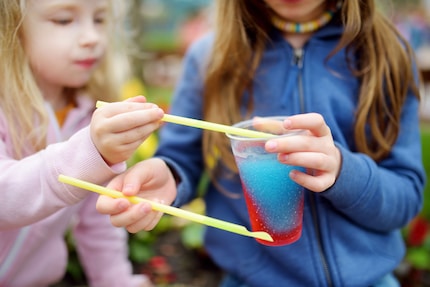
News + Trends
IFA: Ninja announces slush machine for the home
by Lorenz Keller

Researchers have scrutinised slush drinks. The result: if the iced slush contains a lot of glycerine, this can lead to malaise, hypoglycaemia and even unconsciousness in small children.
Colourful, sweet and ice-cold: There's no getting round slush in summer. At least if the children have their way. Parents would love to avoid the stalls with the supposedly sugary summer drinks. But for once, it's not just sugar that's causing problems. It's the additive glycerol (E422), which is supposed to replace it in the sugar-free version and creates the slushy consistency.
British-Irish researchers have examined 21 cases in a study and identified glycerine as the main cause of health problems in young children who were hospitalised after consuming slush. These children were between two and six years old and, in addition to nausea, suffered primarily from underglycaemia, acute loss of consciousness and hyperacidity of the blood (metabolic acidosis).
None of the children had any previous medical problems, but high glycerol residues were found in the urine. The lead author and professor Ellen Crushell is quoted by the BBC with the very apt phrase that the cases investigated could be "the tip of the iceberg", as children with milder symptoms would not present to hospital. She also emphasises that the slush drinks, which are consumed thousands of times a day, are tolerated by most people without any problems.

Despite this, the study team recommends adjusting the recommendations. Currently, the Food Standards Agency (FSA) advises that children under the age of five should not sip slush drinks
The authors are of the opinion that parents can only let eight-year-olds reach for the straw with peace of mind. However, they do not reveal how parents should keep their children away from the omnipresent temptation. The German Federal Institute for Risk Assessment (BfR) also commented in a statement on the glycerine issue:
«The assessment of the measured glycerol concentrations in a total of 62 slush ice samples showed that younger children can already ingest amounts of glycerol that correspond to or exceed the therapeutically effective dose at consumption levels below 200 millilitres (ml).»
From the BfR's point of view, there would be health concerns above this "therapeutic" dose of 250 milligrams per kilogramme of body weight. The bad news: it's not worth doing the maths, as there is no maximum permitted amount of glycerine and you're unlikely to find a slush stand that lists it.
Despite this, the institute provides a sample calculation according to which a five-year-old child weighing 20 kilograms could drink almost 200 millilitres of slush before reaching the dose, provided the drink has the average glycerine content of around 26 grams per litre. But who knows for sure.
The institute's succinct advice: "Consumers can do without slush ice." And producers could check whether glycerine is necessary in slushies. After all, a third of the samples did not contain any glycerine at all, while the concentration in the remaining samples was between one and 142 grams per litre.
The glycerine problem with slushies could be even bigger in the UK than it is here. There, the successful sugar tax ensures that fewer people are overweight. If a drink contains five grams of sugar per 100 millilitres, 18 pence per litre is charged. From 8 grams of sugar, the tax is 24 pence.
Suppliers and consumers can save money by switching to sugar-free drinks. Like slushies, for example, which contain plenty of glycerine. In this country, your child has a better chance of getting what the colourful slush looks like: a good portion of sugar - combined with an unknown amount of glycerine. Not much better either. If you want to know exactly what's being greedily sucked through the straw, it's best to make the summer drink yourself.
Simple writer and dad of two who likes to be on the move, wading through everyday family life. Juggling several balls, I'll occasionally drop one. It could be a ball, or a remark. Or both.
From the latest iPhone to the return of 80s fashion. The editorial team will help you make sense of it all.
Show all